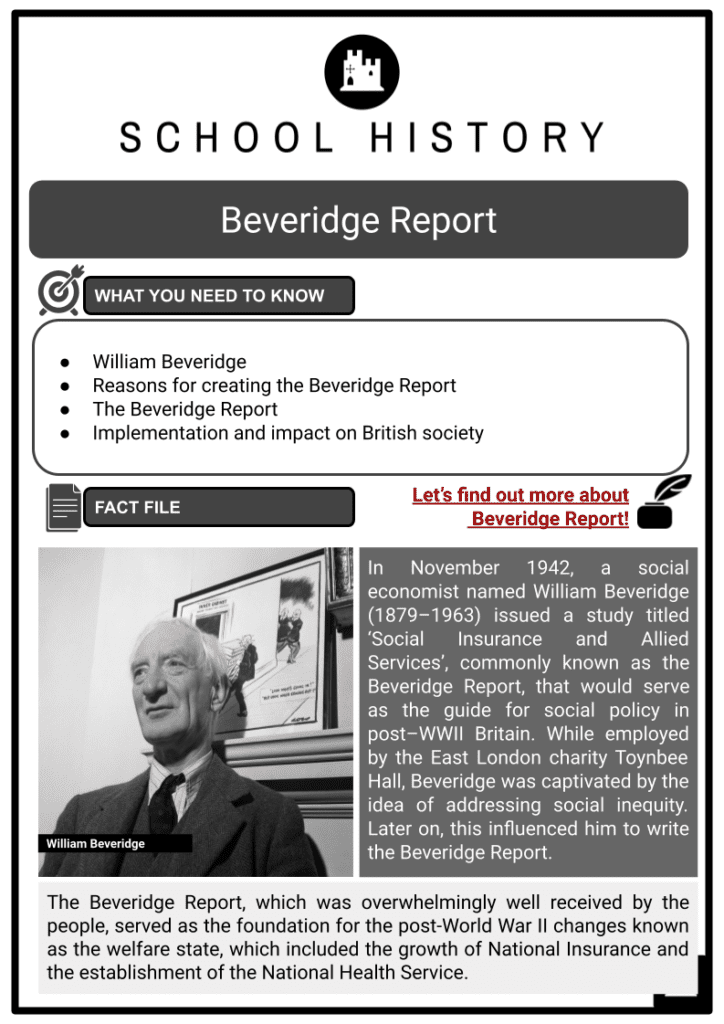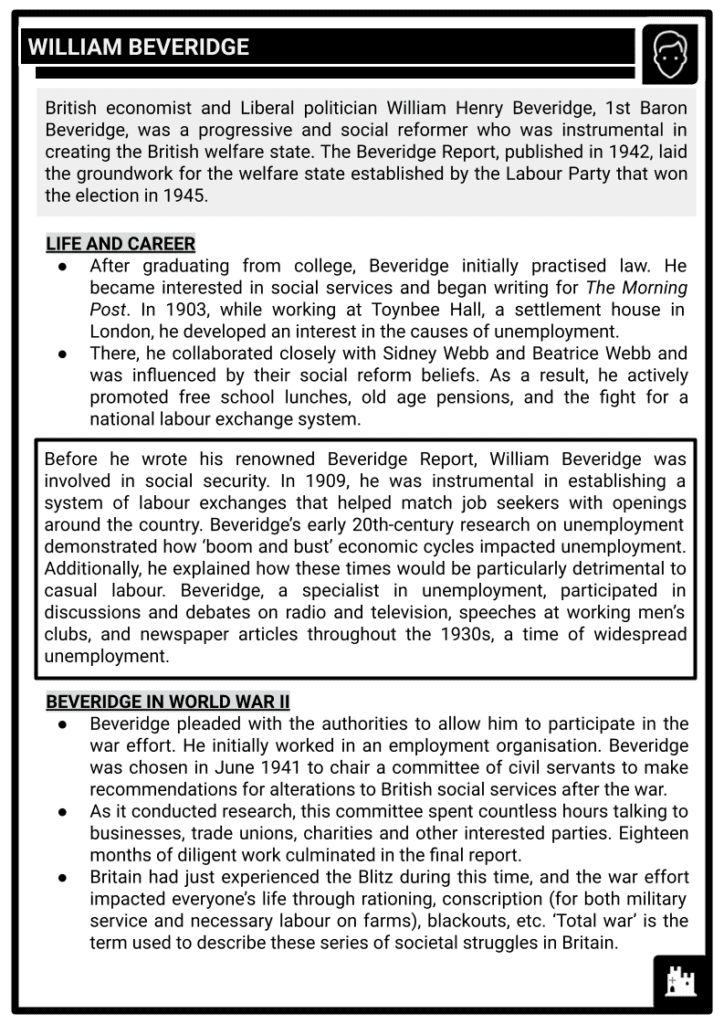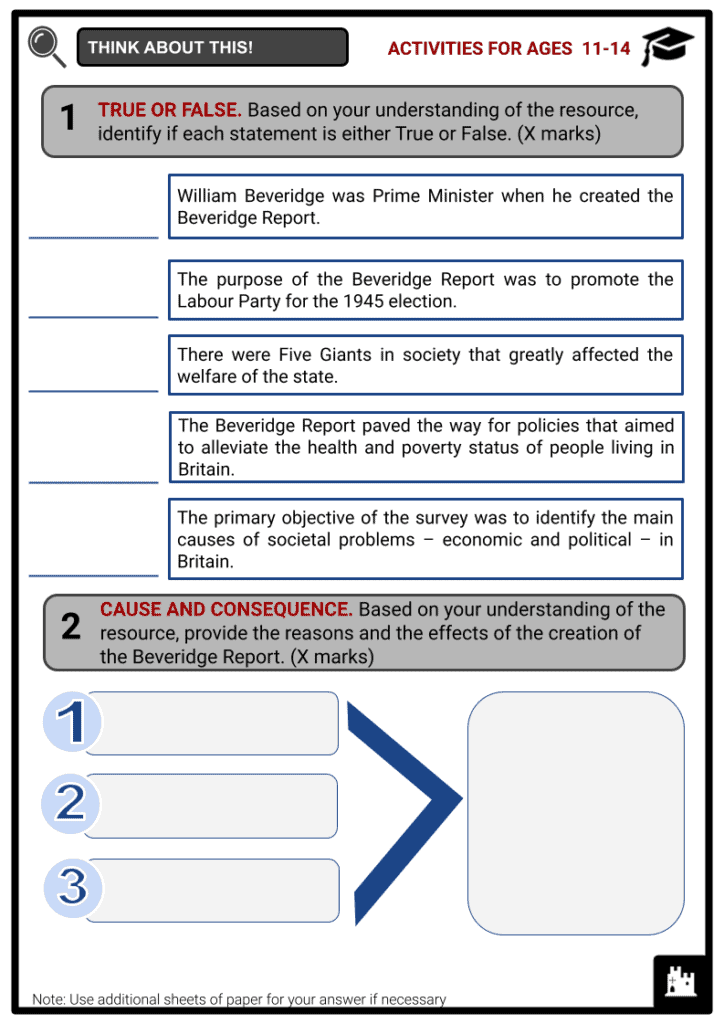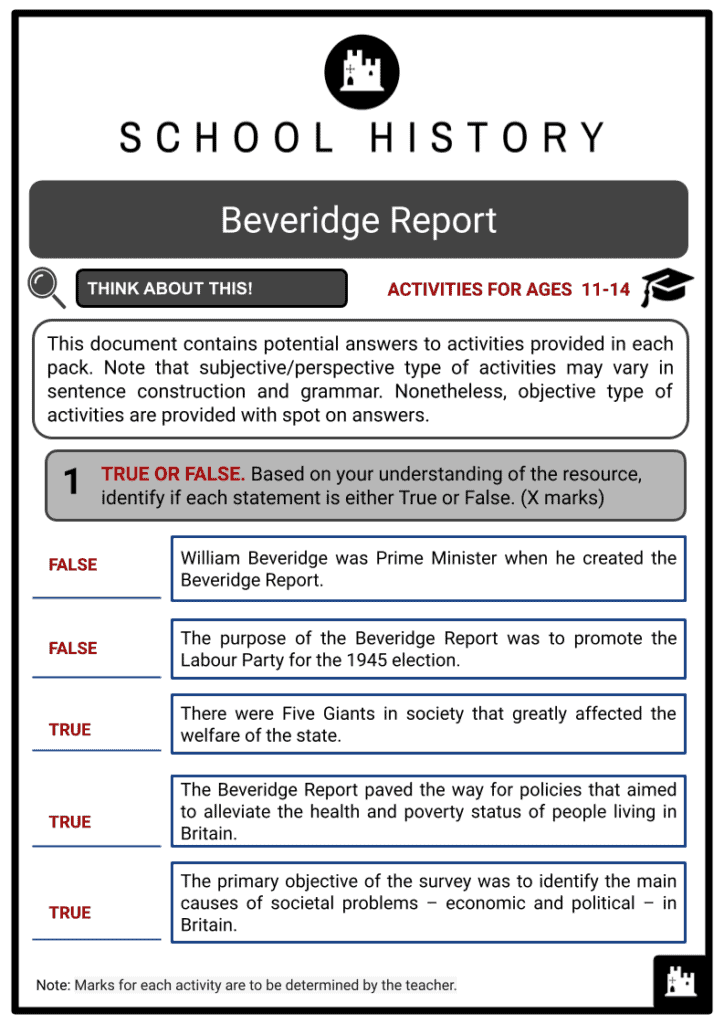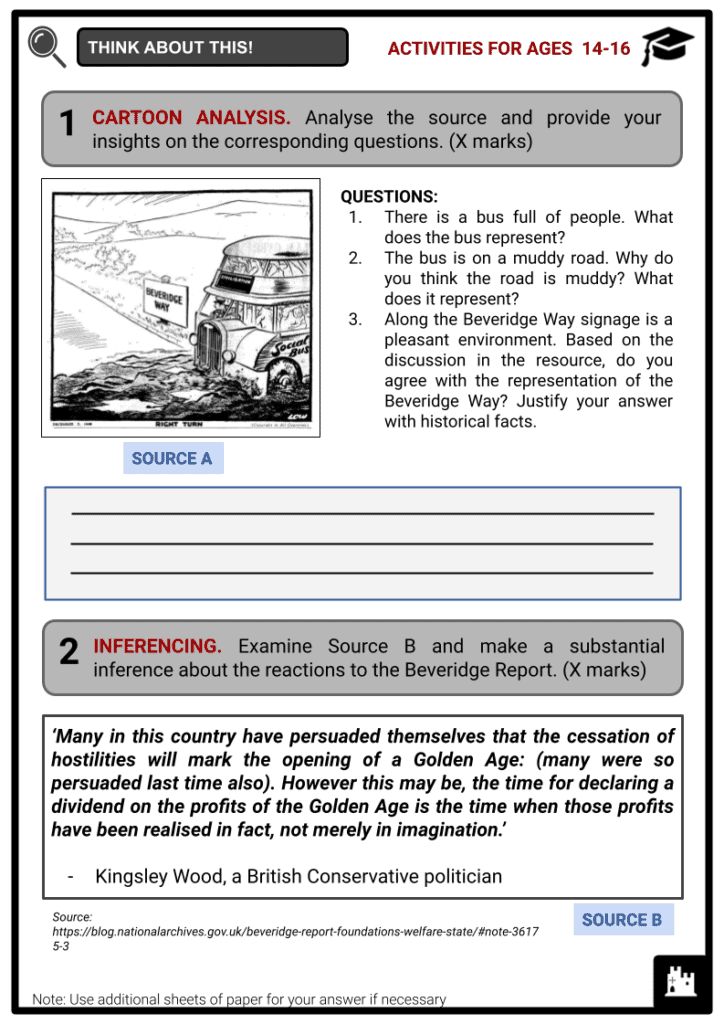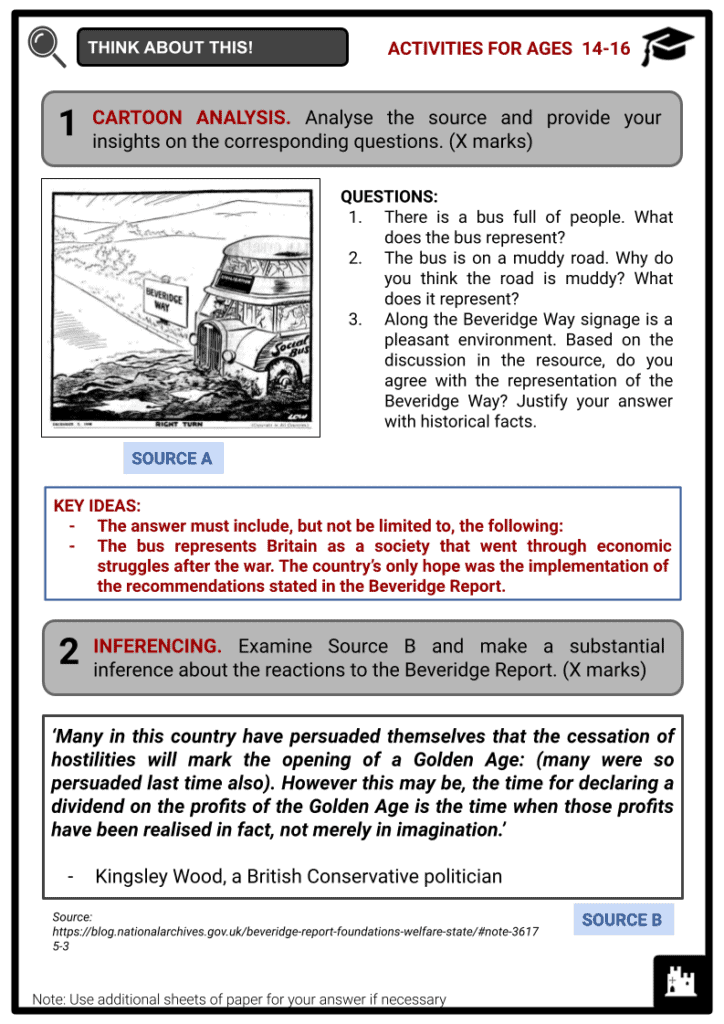Beveridge Report Worksheets
Do you want to save dozens of hours in time? Get your evenings and weekends back? Be able to teach about the Beveridge Report to your students?
Our worksheet bundle includes a fact file and printable worksheets and student activities. Perfect for both the classroom and homeschooling!
Summary
- William Beveridge
- Reasons for creating the Beveridge Report
- The Beveridge Report
- Implementation and impact on British society
Key Facts And Information
Let’s find out more about the Beveridge Report!
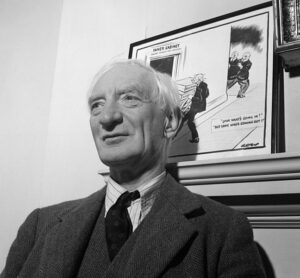
In November 1942, a social economist named William Beveridge (1879–1963) issued a study titled ‘Social Insurance and Allied Services’, commonly known as the Beveridge Report, that would serve as the guide for social policy in post–WWII Britain. While employed by the East London charity Toynbee Hall, Beveridge was captivated by the idea of addressing social inequity. Later on, this influenced him to write the Beveridge Report. The Beveridge Report, which was overwhelmingly well received by the people, served as the foundation for the post-World War II changes known as the welfare state, which included the growth of National Insurance and the establishment of the National Health Service.
WILLIAM BEVERIDGE
- British economist and Liberal politician William Henry Beveridge, 1st Baron Beveridge, was a progressive and social reformer who was instrumental in creating the British welfare state. The Beveridge Report, published in 1942, laid the groundwork for the welfare state established by the Labour Party that won the election in 1945.
LIFE AND CAREER
- After graduating from college, Beveridge initially practised law. He became interested in social services and began writing for The Morning Post. In 1903, while working at Toynbee Hall, a settlement house in London, he developed an interest in the causes of unemployment.
- There, he collaborated closely with Sidney Webb and Beatrice Webb and was influenced by their social reform beliefs. As a result, he actively promoted free school lunches, old age pensions, and the fight for a national labour exchange system.
- Before he wrote his renowned Beveridge Report, William Beveridge was involved in social security. In 1909, he was instrumental in establishing a system of labour exchanges that helped match job seekers with openings around the country. Beveridge’s early 20th-century research on unemployment demonstrated how ‘boom and bust’ economic cycles impacted unemployment. Additionally, he explained how these times would be particularly detrimental to casual labour. Beveridge, a specialist in unemployment, participated in discussions and debates on radio and television, speeches at working men’s clubs, and newspaper articles throughout the 1930s, a time of widespread unemployment.
BEVERIDGE IN WORLD WAR II
- Beveridge pleaded with the authorities to allow him to participate in the war effort. He initially worked in an employment organisation. Beveridge was chosen in June 1941 to chair a committee of civil servants to make recommendations for alterations to British social services after the war.
- As it conducted research, this committee spent countless hours talking to businesses, trade unions, charities and other interested parties. Eighteen months of diligent work culminated in the final report.
- Britain had just experienced the Blitz during this time, and the war effort impacted everyone’s life through rationing, conscription (for both military service and necessary labour on farms), blackouts, etc. ‘Total war’ is the term used to describe these series of societal struggles in Britain.
REASONS FOR CREATING THE BEVERIDGE REPORT
- The Labour Party and the Conservative Party formed a coalition in 1940, at the height of the Second World War. On 10 June 1941, Labour MP and Minister without Portfolio Arthur Greenwood announced the formation of an inter-departmental committee to analyse British social insurance and related services.
- The coalition government commissioned the Inter-Departmental Committee on Social Insurance and Allied Services, presided over by Sir William Beveridge, to study Britain’s social services in 1941. The committee’s report, which was presented to parliament in November 1942, called for the creation of a new kind of welfare state to end ‘want’, provide social insurance ‘from the cradle to the grave’, and prevent social deprivation like that experienced during the pre-Second World War economic depression.
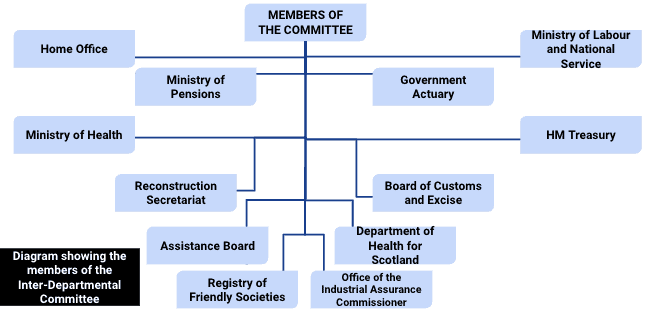
- The report ‘envisages a future of state and citizen cooperation’ partially from the collectivism of total war, in which the state, communities and people banded together to strive for the common good. Free school milk and meals were introduced in 1941, which was likely a communal effort to raise living conditions and a forerunner to the reforms outlined by Beveridge.
THE BEVERIDGE REPORT
- The final suggestions on the report reflected Beveridge’s own opinions. It was deemed improper for the other committee members, who were government servants, to contribute to the proposals. Beveridge outlined five ‘giants’ that society must address: Want, Disease, Ignorance, Squalor, and Idleness.
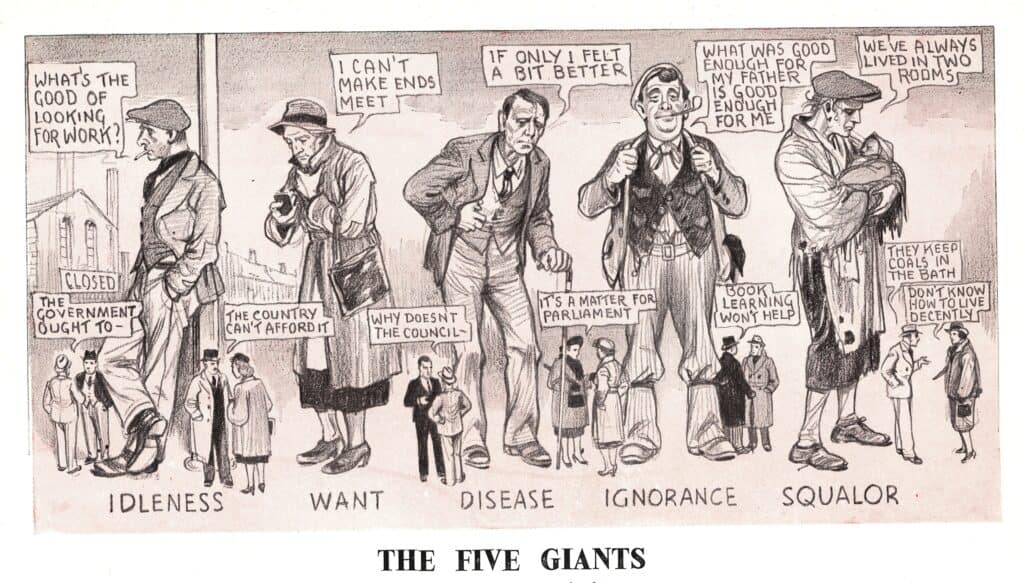
Cartoon depicting the FIVE GIANTS - Through improved social services, such as a free health service (later the National Health Service), family allowances and social insurance to help people deal with times of unemployment, Beveridge aimed to beat the giants.
- Beveridge felt that ‘want’ was, in some respects, the simplest of these giants to combat. When the report was written, the Treasury described these giants as having an ‘increasing order of strength and ferocity’. While his report did suggest education reforms to combat ignorance, a post-war wave of council housing that would significantly aid in the fight against squalor, and the possibility of a fully employed economy eliminating idleness, the report set itself out as simply the first step down the path of ‘social progress’ to a society free of these giants.
- Three principles guided the report’s recommendations:
- Future proposals shouldn’t be constrained by ‘sectional interests’. There should be a revolution when the globe is experiencing a process, not patch-up decisions or policies.
- One element of a ‘comprehensive policy of social progress’ is social insurance. Want, Diseases, Ignorance, Squalor and Idleness were the five obstacles in the way of restoration.
- The state secures the service and contributions, and social security policies ‘must be achieved by cooperation between the State and the Individual.’ In establishing a national minimum, the government ‘should not suffocate incentive, opportunity, or responsibility; rather, it should allow for and encourage each person to take voluntary action to provide more than that minimum for himself and his family.’
IMPLEMENTATION AND IMPACT ON BRITISH SOCIETY
- According to surveys conducted by William Beveridge and his team, most of the British public supported the report’s recommendations and wanted them to be implemented as quickly as feasible. After the General Election in 1945, the Labour Administration implemented Beveridge’s suggestions by establishing the welfare state and National Health Service. Labour politicians were in favour of the plans.
- The implementation of the Beveridge Report resulted in the passing of different policies that focused on the welfare of all people living in Britain. Some of these policies were:
- Family Allowances Act 1945
- National Insurance (Industrial Injuries) Acts 1946
- National Health Service Act 1946
- Pensions (Increase) Act 1947
- Landlord and Tenant (Rent Control) Act 1949
FAMILY ALLOWANCES ACT 1945
- The Family Allowances Act of 1945, a British Act of Parliament, was the country’s first statute to offer child benefits. It was passed on 15 June 1945, while Winston Churchill led the caretaker Conservative government, but it wasn’t implemented until 6 August 1946, when Clement Attlee led the Labour government.
- One of the suggestions made by the Beveridge Report in 1942 was family allowances. During the Second World War, the Labour Party briefly discussed pushing for allowances, but the trade unions vetoed a party conference resolution to that effect out of concern that the amount provided would be taken into account in wage negotiations, leaving workers no better off.
NATIONAL INSURANCE ACT OF 1946
- During the Attlee administration, the British parliament approved the National Insurance Act 1946 (c. 67), establishing a thorough social security system across the United Kingdom.
- Everyone of working age was required to make a weekly contribution under the statute. Mothers were entitled to an allowance (of 18 weeks) for each child and a lump sum when the child was born if they had been paying National Insurance.
NATIONAL HEALTH SERVICE ACT 1946
- The National Health Service was established by the National Health Service Act 1946 (c. 81), which was the first application of the Beveridge model, on 5 July 1948 in England and Wales. The National Health Service (Scotland) Act of 1947 established a separate NHS for Scotland accountable to the Secretary of State for Scotland. However, ‘National Health Service’ implies a single health service for all of the United Kingdom. Instead, one NHS was established for England and Wales under the authority of the Secretary of State for Health.
PENSIONS ACT 1947
- The United Kingdom’s Parliament passed the Pensions (Increase) Act in 1947. It was approved during Clement Attlee’s Labour administration. The benefit rates for pensioners were significantly enhanced as a result.
LANDLORD AND TENANT ACT 1949
- The Landlord and Tenant (Rent Control) Act 1949 (12, 13 & 14 Geo. 6. c. 40) was a British law intended to reinstate landlords’ use of excessive rent demands. It broadened the 1946 Furnished Houses (Rent Control) Act’s restrictions.

